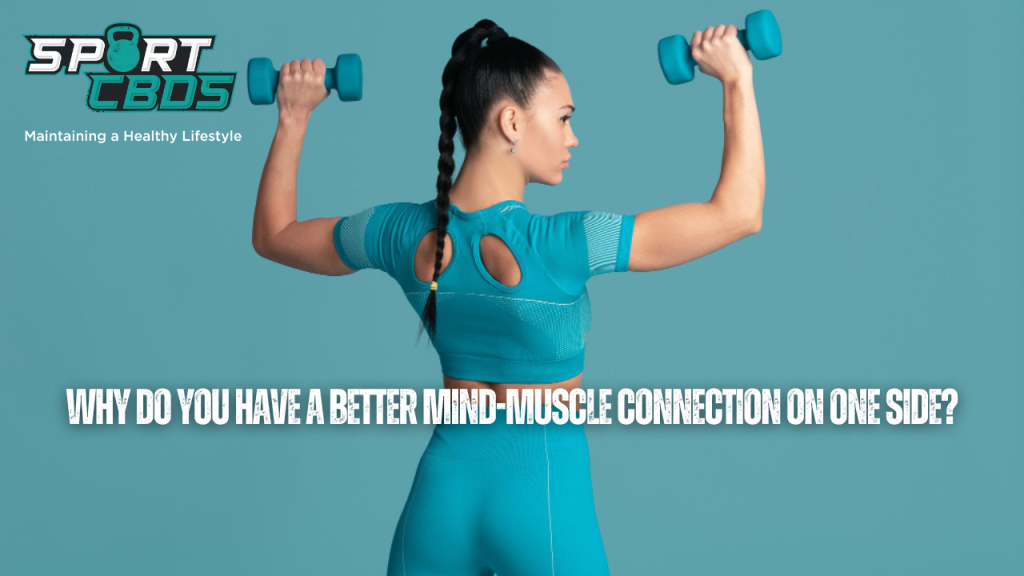
One-Sided Dominance: Do You Have a Better Mind-Muscle Connection On One Side?
The mind-muscle connection is a conscious and deliberate muscle contraction. It’s the ability to focus on your muscles in motion during exercise, and it plays a crucial role in fitness.
The concept is not new, but it’s gaining more attention as people realize its importance in maximizing workout results and improving overall body function.
The mind-muscle connection is more than just a fitness buzzword. It’s a fundamental aspect of any successful workout routine.
When you’re able to effectively engage your mind with your muscles, you can significantly enhance your exercise performance, increase muscle strength and size, and reduce your risk of injury. It’s not just about lifting weights or running miles; it’s about ensuring that every movement counts.
Why Do You Have a Better Mind-Muscle Connection On One Side?
The concept of “better mind-muscle connection on one side” refers to the phenomenon where an individual experiences a stronger connection between their brain and muscles on one side of their body. This often results from side dominance, where one side (usually the right for right-handed individuals and vice versa) is used more frequently in daily activities, leading to a stronger mind-muscle connection. It can also stem from past injuries that make an individual unconsciously favor one side. This imbalance can significantly impact workouts and overall fitness, leading to uneven muscle development and strength. However, with strategies like proper warm-ups, focused exercises, using dumbbells for balanced muscle development, and consciously working on the weaker side, it’s possible to improve the mind-muscle connection and achieve balanced strength and muscle development.
Understanding the Mind-Muscle Connection
The science behind the mind-muscle connection is fascinating. It’s all about neuromuscular control. Your brain communicates with your muscles through motor neurons, which send signals to your muscles to contract and move. When you focus your mind on the muscle you’re working, you’re essentially increasing the neural drive or signal to that muscle. This can lead to more significant muscle activation and ultimately better results from your workouts.
The mind-muscle connection can significantly affect your workouts. For one, it can improve the quality of each rep by ensuring that the target muscle is doing the work instead of letting other muscles take over. This can lead to more efficient workouts, better muscle development, and improved muscle symmetry.
Moreover, the mind-muscle connection can help you prevent injuries. By focusing on the muscle you’re working, you’re more likely to use proper form, which can reduce the risk of injury. It can also help you identify muscle imbalances. If you notice that one side feels stronger or more engaged than the other, it could indicate a lack of mind-muscle connection on the weaker side.
In the next sections, we’ll delve deeper into the issue of one-sided mind-muscle connection, how to identify it, and strategies to improve it. Stay tuned!
The Issue of One-Sided Mind-Muscle Connection
A common issue many people face in their fitness journey is a stronger mind-muscle connection on one side of the body. This is often due to several reasons:
- Dominant Side: Most people have a dominant side that they use more often, leading to a stronger mind-muscle connection on that side.
- Injury or Discomfort: If you’ve had an injury on one side, you might unconsciously favor the other side, leading to a stronger connection.
- Lack of Awareness: Sometimes, you might not be aware that you’re favoring one side during your workouts.
The impact of a one-sided mind-muscle connection on your workouts and overall fitness can be significant. It can lead to muscle imbalances, where one side of your body becomes stronger and more developed than the other. This can affect your performance in various exercises and even daily activities. Moreover, it can increase your risk of injury, as the weaker side might not be able to handle the same amount of stress as the stronger side.
Related: The Strength Showdown: Do Women Have Stronger Legs Than Men in General?
How to Identify a One-Sided Mind-Muscle Connection
Identifying a one-sided mind-muscle connection requires a keen sense of body awareness. Here are some signs and symptoms to look out for:
- Uneven Muscle Development: If one side of your body looks more developed than the other, it could be a sign of a one-sided mind-muscle connection.
- Strength Imbalance: If you can lift more weight or perform more reps with one side, it might indicate a stronger connection on that side.
- Feeling of Disconnection: If you struggle to feel a particular muscle working during an exercise, it could suggest a lack of mind-muscle connection.
As for self-assessment techniques, here are a few methods you can use:
- Unilateral Exercises: Perform exercises that work one side of your body at a time, like single-arm curls or single-leg squats. Pay attention to any differences in strength or muscle engagement.
- Mirror Check: Use a mirror to observe your form during exercises. Look for any asymmetries in your movement.
- Mindful Exercise: During your workouts, focus on the muscle you’re working. Try to feel it contracting and relaxing.
In the next sections, we’ll explore strategies to improve your mind-muscle connection and overcome one-sided dominance.
Strategies to Improve Mind-Muscle Connection
Improving your mind-muscle connection, especially if you’re dealing with one-sided dominance, can significantly enhance your workouts and overall fitness. Here are some strategies to help you achieve this:
- Warm-Up: A proper warm-up can help prepare your mind and muscles for the workout ahead. It increases blood flow to your muscles, enhances muscle flexibility, and helps you focus on the muscles you’ll be working. Try to include dynamic stretches and light cardio in your warm-up routine.
- Focus on the Muscle: During your workouts, concentrate on the muscle you’re working. Visualize it contracting and relaxing with each rep. This can help increase muscle activation and improve your mind-muscle connection.
- Use Dumbbells: Dumbbells can be particularly useful for improving a one-sided mind-muscle connection. They allow each side of your body to work independently, which can help balance muscle development and strength.
- Overcome Side Dominance: If you have a dominant side, try starting your workouts with your non-dominant side. This can help ensure that your non-dominant side gets a good workout before you become fatigued.
Overcoming One-Sided Mind-Muscle Connection
I noticed that my right side was significantly stronger and more developed than my left. I realized that I had a stronger mind-muscle connection on the right side, which was affecting my workouts and leading to muscle imbalances.
I decided to implement the strategies mentioned above. I started my workouts with a thorough warm-up, focusing on activating both sides of my body. During the workouts, I concentrated on the muscle I was working, visualizing it contracting and relaxing with each rep. I also started using dumbbells more often, which allowed each side of my body to work independently. Finally, I made a conscious effort to start my workouts with the non-dominant side.
After several months, I noticed significant improvements. My left side became stronger, and my muscle development became more balanced. I also felt a stronger mind-muscle connection on the left side, which improved my workouts and overall fitness.
My experience shows that with the right strategies and consistent effort, it’s possible to improve a one-sided mind-muscle connection and achieve balanced muscle development and strength.
For further reading, here are two studies that delve into the mind-muscle connection and its impact on muscle activation and strength:
- The impact of attentional focus on the neuromuscular system – This study found that focusing on the muscle during exercise can increase muscle activation.
- Differential effects of attentional focus strategies during long-term resistance training – This study found that an internal focus (focusing on the muscle) can lead to greater strength gains.
Related: The Ultimate Guide: How Often Should You Max Out Lifting Weights?
The Importance Of Grip Strength and Mind Muscle Connection
Grip strength can play a significant role in achieving a better mind-muscle connection on one side. By focusing on improving grip strength, individuals can enhance their neuromuscular awareness, leading to a stronger mind-muscle connection.
This is particularly beneficial when one side of the body has a weaker grip strength, as targeted exercises can help balance the strength and muscle development on both sides. A study published in the Journal of Strength and Conditioning Research found that grip strength training led to increased muscle activation, demonstrating the potential benefits for mind-muscle connection.
Tools like the hand grip strengthener available on Amazon can be particularly useful for these exercises. Additionally, incorporating products like those available at the Sport CBDS Store can support overall muscle recovery and wellness, further enhancing your fitness journey.
FAQs
Here are some common questions and answers about the mind-muscle connection:
How do you fix a bad mind-muscle connection?
Fixing a bad mind-muscle connection involves several strategies. These include proper warm-up, focusing on the muscle during exercise, using dumbbells for balanced muscle development, and overcoming side dominance. It’s also important to practice mindful exercise and maintain a consistent workout routine.
Can you improve mind-muscle connection?
Yes, you can improve your mind-muscle connection. It involves increasing your body awareness and focusing on the muscle you’re working during exercise. Regular practice and consistency are key to improving your mind-muscle connection.
Why do I struggle with mind-muscle connection?
Struggling with mind-muscle connection can be due to several reasons. These include lack of body awareness, improper form during exercise, and muscle imbalances. It can also be due to not focusing on the muscle during exercise or having a dominant side that you use more often.
Why is my left side weaker than my right?
If your left side is weaker than your right, it could be due to side dominance, where you use your right side more often. It could also be due to a lack of mind-muscle connection on your left side. Implementing strategies to improve your mind-muscle connection can help balance your muscle strength and development.
Final Thoughts…
The mind-muscle connection is a crucial aspect of fitness. It’s not just about lifting weights or running miles; it’s about ensuring that every movement counts. A balanced mind-muscle connection can significantly enhance your workouts, improve muscle development and symmetry, and reduce your risk of injury.
If you’re dealing with a one-sided mind-muscle connection, remember that improvement is possible. With the right strategies and consistent effort, you can enhance your mind-muscle connection and achieve balanced muscle development and strength. Keep pushing, stay focused, and remember that every step you take brings you closer to your fitness goals.
Do you have a better mind-muscle connection on one side? Have our tips been beneficial to you? We’d love to hear your feedback, so please share your thoughts in the comments section below.
If you’re a sports enthusiast who utilizes CBD for optimal recovery after intense workouts, then you’ve found your tribe. Welcome to Sport CBDs, where we push our limits in training and prioritize recovery in the most effective way possible.
We regularly share workout routines on our YouTube channel and offer a range of health and fitness products designed to give you that competitive edge.
Why not explore the high-quality CBD products we proudly feature on our site? Visit the Sport CBDs Store by clicking here. In addition to CBD, we also offer an array of fitness clothing and yoga accessories to complement your active lifestyle.
Until next time, we wish you the best in your fitness journey. Remember, your progress is our passion. Stay strong and keep pushing!

Lee
Founder – Sport CBDs
Featured Image Attribution – Image by master1305 on Freepik

